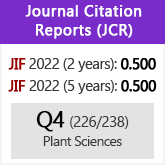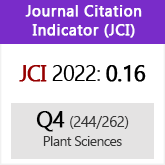Andromonoecy and buzz pollination in Solanum species (Solanaceae) endemic to the Canary Islands
DOI:
https://doi.org/10.3989/ajbm.2006.v63.i1.35Keywords:
andromonoecy, buzz pollination, Canary Islands, SolanumAbstract
We investigated the pollination and reproductive biology of two Canary Island endemics, Solanum vespertilio and S. lidii (Solanaceae). We measured male function (pollen development), female function (fruit initiation) and spatial arrangement of reproductive parts within flowers and inflorescences. Furthermore, we observed flower visitors and monitored visitation rates. Both species of Solanum display andromonoecy: Longstyled flowers are functionally hermaphrodite and borne proximally on the inflorescences, while short-styled flowers are functionally male and borne distally on inflorescences. Large bees capable of buzzing were the main flower visitors. In particular, the endemic Canarian bumblebee, Bombus terrestris canariensis, was a frequent visitor and pollen vector of S. vespertilio.
Downloads
References
Anderson, G.J. & Symon, D.E. 1989. Functional dioecy and andromonoecy in Solanum. Evolution 34: 204-219. doi:10.2307/2409175
Barrett, S.C.H. 1996. The reproductive biology and genetics of island plants. Philosophical Transactions of the Royal Society of London Series B 351: 725-733. doi:10.1098/rstb.1996.0067
Bohs, L. & Olmstead, R.G. 2001. A reassessment of Normania and Triguera (Solanaceae). Plant Systematics and Evolution 228: 33-48. doi:10.1007/s006060170035
Bowers, K.A.W. 1975. The pollination ecology of Solanum rostratum (Solanaceae). American Journal of Botany 62: 633-638. doi:10.2307/2441943
Coleman, J.R. & Coleman, M.A. 1982. Reproductive biology of an andromonoecious Solanum (S. palinacanthum Dunal). Biotropica 14: 69-75. doi:10.2307/2387763
Diggle, P. 1991. Labile sex expression in andromonoecious Solanum hirtum: floral development and sex determination. American Journal of Botany 377-393. doi:10.2307/2444960
Diggle, P. 1994. The expression of andromonoecy in Solanum hirtum (Solanaceae): phenotypic plasticity and ontogenetic contingency. American Journal of Botany 1354-1365. doi:10.2307/2445411
Dulberger, R. 1981. The floral biology of Cassia didymobotrya and C. auriculata. American Journal of Botany 68: 1350-1360. doi:10.2307/2442734
Gómez Campo, C. 1996. Libro rojo de especies vegetales amenazados de las Islas Canarias. Viceconsejería de Medio Ambiente del Gobierno de Canarias. Santa Cruz de Tenerife.
Helfgott, D.M., Francisco-Ortega, J., Santos-Guerra, A., Jansen, R.K. & Simpson, B.B. 2000. Biogeography and breeding system evolution of the woody Bencomia alliance (Rosaceae) in Macaronesia based on ITS sequence data. Systematic Botany 25: 82-97. doi:10.2307/2666675
Hohmann, H., La Roche, F., Ortega, G. & Barquin, J. 1993. Bienen, Wespen und Ameisen der Kanarischen Inseln (Insecta: Hymenoptera: Aculeata). Veröffentlichungen aus dem Übersee- Museum Bremen. Bremen.
Linsley, E.G. & Cazier, M.A. 1963. Further observations on bees which take pollen from plants of the genus Solanum. Pan-Pacific Entomologist 39: 1-18.
Olesen, J.M., Dupont, Y.L., Ehlers, B.K. & Hansen, D.M. 2003. Heterostyly in the Canarian endemic Jasminum odoratissimum (Oleaceae). Nordic Journal of Botany 23: 537-540. doi:10.1111/j.1756-1051.2003.tb00431.x
Symon, D.E. 1979. Sex forms in Solanum (Solanaceae) and the role of pollen collecting insects. In: Hawkes, J.G., Lester, R.N.L. & Skelding, A.D. (eds.), The biology and taxonomy of the Solanaceae: 385-397. Academic Press. London.
Whalen, M.D. & Costich, D.E. 1986. Andromonoecy in Solanum. In: D’Arcy, W.G. (ed.), Solanaceae: Biology and systematics: 284-302. Columbia University Press. New York.
Downloads
Published
How to Cite
Issue
Section
License
Copyright (c) 2006 Consejo Superior de Investigaciones Científicas (CSIC)

This work is licensed under a Creative Commons Attribution 4.0 International License.
© CSIC. Manuscripts published in both the printed and online versions of this Journal are the property of Consejo Superior de Investigaciones Científicas, and quoting this source is a requirement for any partial or full reproduction.All contents of this electronic edition, except where otherwise noted, are distributed under a “Creative Commons Attribution 4.0 International” (CC BY 4.0) License. You may read here the basic information and the legal text of the license. The indication of the CC BY 4.0 License must be expressly stated in this way when necessary.
Self-archiving in repositories, personal webpages or similar, of any version other than the published by the Editor, is not allowed.

















